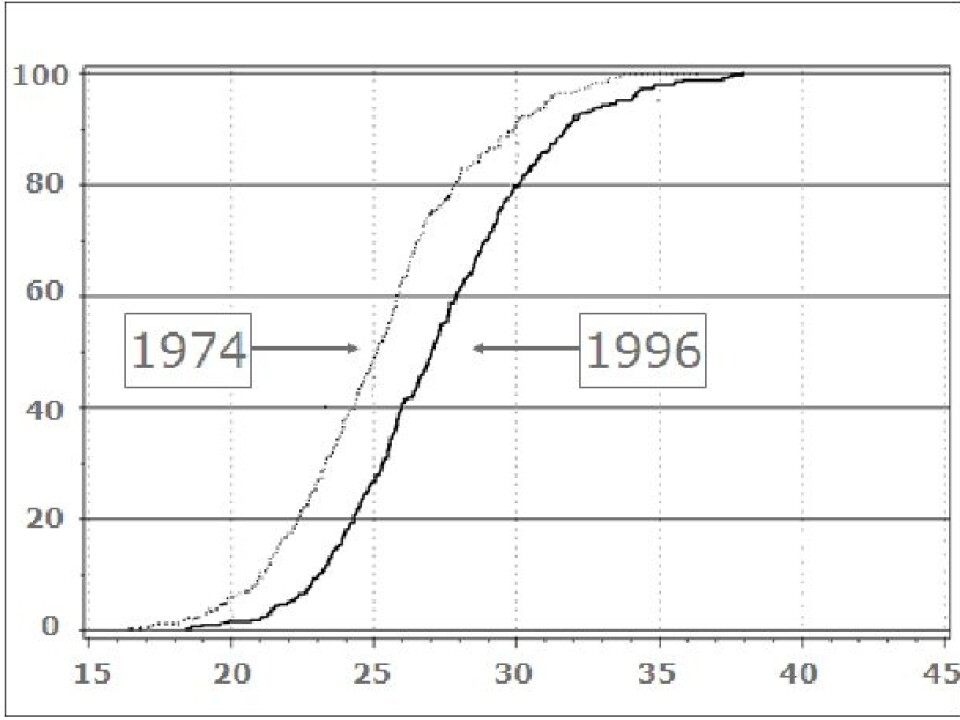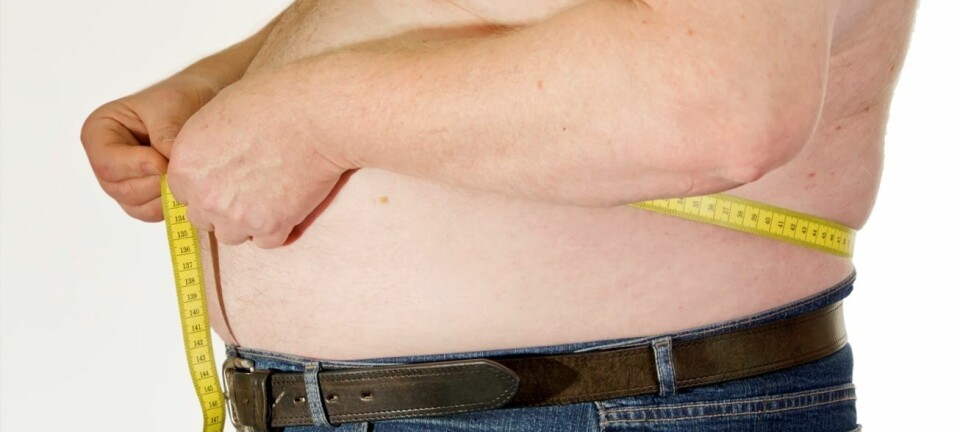
New theory: CO2 makes you fat
Danish researchers have announced a rather wild hypothesis: Perhaps we are getting fatter and fatter because of the increasing CO2 levels in the atmosphere.
No, this is not 1 April – and this is not an April Fool’s hoax.
Mad as it may sound, Danish researchers have announced a theory that may not only explain why people all over the world are getting fatter and fatter, but also warn of the serious consequences for life on Earth of continued pollution of the atmosphere by CO2 emissions.
In itself, the theory is quite simple: CO2 contributes to making us fat.
“There’s something in the air”
The theory arose several years ago, when Lars-Georg Hersoug studied the development of obesity among people who had been followed over a number of years in the so-called MONICA studies (Monitoring of Trends and Determinants in Cardio-vascular Disease) in Denmark. These studies have mapped the lifestyles of thousands of Danes.

Hersoug was surprised to see that both fat and thin people taking part in the studies over a 22-year period had put on weight – and the increase was proportionately the same.
Orexins – which are neuropeptide hormones – in the brain stimulate wakefulness and energy expenditure. These hormones may be affected by CO2, and this can cause us to go to bed later, affecting our metabolism so it is easier for us to put on weight. But orexins are also involved in the stimulation of food intake.
“The normal theory is that fat people get fatter because they don’t move as much as they should,” says Hersoug, now a post-doc at the Research Centre for Prevention and Health at Glostrup University Hospital. “But the study showed that thin people also get fatter, and this happened over the whole of the 22-year period of the study.”
Obesity may follow CO2 concentration
Hersoug has since studied events and research results that could support his theory.
1. He says the development in obesity in the US was fastest in the period 1986-2010 on the east coast – where CO2 concentrations are highest.
2. A study from 2010, covering 20,000 animals in various laboratories, showed that all the animals put on weight, even though they were given food under controlled conditions and should therefore not have put on weight. The animals studied included dogs, cats, mice and monkeys. And when researchers studied rats in both urban and rural environments in the US, the result was the same.
“The probability that all animals of eight different species put on weight from random causes is one in 10,000,000,” says Hersoug. “This indicates that the animals were affected by environmental factors – and you can speculate on what these environmental factors are.”
3. A quite decisive element was added to the researchers’ theory in 2007, when a study revealed that the pH value of blood – its acidity – affects nerve cells in the brain that regulate our appetite and metabolism: orexins.
CO2 makes us eat more
This discovery made it possible to develop a precise hypothesis for how CO2 makes us fatter: We breathe more CO2, which makes our blood more acidic; this affects our brain, so we want to eat more.
In 2011, together with researchers Anders Mikael Sjödin and Arne Astrup from the University of Copenhagen, Hersoug started to test the hypothesis on humans.
At the university’s Department of Human Nutrition, they placed six young men in special climate rooms, where some of them were exposed to increased amounts of CO2. After seven hours, the men were allowed to eat as much as they liked.
This little pilot study showed that the men with the greater amount of CO2 in their blood ate six percent more food than the men who had been in climate rooms with a normal amount of CO2.
“We could also see that the extra amount of CO2 caused the men’s heartbeat to rise, and this gives us an indication that CO2 affects the brain’s nerve cells – orexins in the hypothalamus – which among other functions control our appetite and the composition of our nutrient intake,” says Hersoug.
“A very small change in the activity of these nerve cells will presumably have great importance for our development of obesity or for maintaining our weight.”
Does CO2 give men beer guts?
If the researchers’ hypothesis is correct, it raises many questions.
CO2 is found in the bubbles in fizzy drinks and beer – does that have any importance for obesity?
“Of course I have considered whether CO2 has very local impacts, which could explain how beer guts develop,” says the researcher.
“Several studies have not shown any connection, but our hypothesis may give sufficient additional arguments to warrant new studies of this aspect.”
Many people will also ask whether painful slimming diets or long, boring runs to sweat off excess weight make any sense if it is CO2 in the atmosphere that makes us fatter.
Exercise and vegetables can limit the ‘CO2 effect’
But Hersoug says the hypothesis gives us no excuse for dropping diets and exercise – on the contrary.
“We know already that a sedentary lifestyle is a risk factor for many diseases,” he says. “According to our theory, this may be because of the higher acidity in the blood arising from a sedentary lifestyle indoors in a CO2 concentration that is higher than it is outdoors.”
On the other hand, he says, “If you’re out running, you get your blood circulating and you can pump much of the CO2 out of your body, so our hypothesis is really further evidence that exercise is healthy. And exercise may be even more necessary in the future, when we can expect even higher CO2 concentrations in the atmosphere.”
Hersoug adds that fruit and vegetables also reduce the blood’s pH value, so the CO2 theory is also an argument for eating more healthily.
‘An interesting idea’
The hypothesis has just been published in the scientific journal ‘Nutrition and Diabetes’ – in part to make other obesity researchers around the world think about the situation. One leading obesity researcher is clinical professor Thorkild I. A. Sørensen, the leader of the Danish Obesity Research Centre, DanORC.
Sørensen, who is at the Department of Public Health at the University of Copenhagen, says he would like to see further concrete studies before he can believe that his three Danish colleagues have found a vital contributory factor to solving the mystery of the obesity epidemic.
“The researchers are quite right in saying that our current understanding of the obesity epidemic is imperfect and that we certainly cannot allow ourselves to conclude that the reason is simply that ‘we eat too much and exercise too little’,” says Sørensen.
“They are quite right in showing interest for other possibilities. Their hypothesis is a new and very interesting idea, clearly inspired by studies using animals in captivity that have also put on weight – and a common factor for these animals and people is the air we breathe.”
Concrete measurements of CO2 and obesity needed
“But there is one problem: the obesity epidemic has developed quite irregularly in time and place, even in a small country such as Denmark, and only a part of the population is affected even though we all breathe the same air,” says Sørensen.
He expects the researchers will say that various tendencies towards obesity must be taken into account. But, he adds, a decisive step in testing whether the hypothesis can stand is to study whether obesity has changed in reality in the delay, equal to the time it takes to develop obesity, after local CO2 concentrations in the air have risen.
“If this is not the case, then the idea that increases in CO2 concentration have triggered the obesity epidemic does not stand as the cause must come before the effect,” says Sørensen.
The answer could lie in the mountains
Hersoug says that making the measurements required by Sørensen can be difficult. Instead, the researchers have considered testing the hypothesis in the heights.
Several studies have shown that you can lose weight in the mountains, where there is less oxygen in the air and where you expire more CO2.
Obesity statistics from the Centers for Disease Control and Prevention in the USA seem to indicate that the obesity epidemic is less widespread in mountain states.
“But at the present time this does not figure in our studies because we feel it is more important to ascertain whether we can show an effect through controlled trials,” says Hersoug. “If we can show an effect, then we will carry out epidemiological studies with humans – but we can’t get the funding for these without verification of our hypothesis.”
Hersoug and his colleagues will soon start conducting trials with rats to see whether they can support the hypothesis – or pull the carpet out from under it. They hope to be able to raise money for further, more comprehensive trials of e.g. the role different types of nutritious diets play together with CO2.
Translated by: Michael de Laine
Scientific links
- A proposed potential role for increasing atmospheric CO2 as a promoter of weight gain and obesity Nutrition and Diabetes (2012) 2, e31; doi:10.1038/nutd.2012.2
- Canaries in the coal mine: a cross-species analysis of the plurality of obesity epidemics; Proceedings of the Royal Society B; doi: 10.1098/rspb.2010.1890
- Control of hypothalamic orexin neurons by acid and CO2; PNAS; doi: 10.1073/pnas.0702676104












